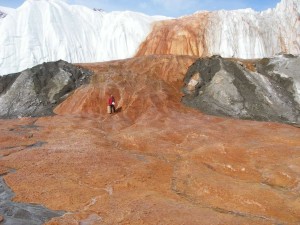
Dr. Jill Mikucki (UT-Knoxville) standing on the snout of the Taylor Glacier at Blood Falls (photo courtesy of Jill Mikucki)
In a recent issue of the journal Science, a team of scientists, including College of Charleston biogeochemist Dr. Peter Lee, described a novel ecosystem in which a microbial community had managed to survive for over a million years in the absence of sunlight and oxygen. The authors believe that as sea levels decreased and glaciers began to advance across Antarctica pockets of seawater became trapped in the McMurdo Dry Valleys and were sealed off from the atmosphere and sunlight by the advancing glaciers. Unlike most subglacial lakes in Antarctica that are totally inaccessible without drilling equipment, this subglacial lake periodically discharges through the Taylor Glacier at a location known as Blood Falls. Using a combination of classical “wet chemistry” methods, modern molecular and genetic techniques, stable isotope analyses and thermodynamic modeling, the team of scientists examined this discharge and found that the surviving microorganisms had adapted to use sulfate andiron compounds as their source of energy but in an unusual way. Normally when microbes use sulfate for energy, they produce hydrogen sulfide (the compound that causes the characteristic smell of salt marshes) as the end product. But in this case, they stopped short of producing hydrogen sulfide and instead used the sulfate as a “catalyst” to derive their energy from iron minerals mobilized from the glacier’s bedrock. These findings provide insight into how life may have survived periods of Neoproterozoic glaciations (“Snowball Earth” events) when some scientists believe that the Earth was entombed in ice. The authors also suggest that similar ecosystems may provide a “refuge” for life in other inhospitable environments, such as Mars and the Jovian moon Europa. Articles can be viewed below:
